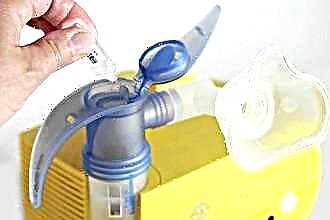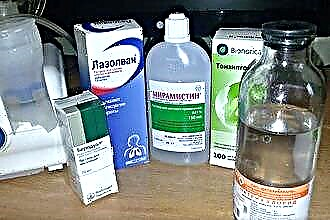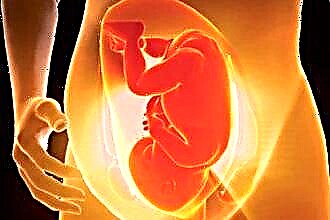Inhalation with adenoids is one of the most convenient ways of administering drugs. But the important point here is in what period it is useful to use inhalation. In case of adenoid disease, three stages of the development of the process are distinguished, differing in the size that the vegetation (proliferation) of the nasopharyngeal tonsil has.
 As a rule, inhalation treatment helps to restrain the development of the disease and relieve its characteristic symptoms only at the first, very early stage of the progression of the adenoids.
As a rule, inhalation treatment helps to restrain the development of the disease and relieve its characteristic symptoms only at the first, very early stage of the progression of the adenoids.
When the pathology passes into the second (with the closure of 2/3 of the coulter height) and the third (complete overlap of the coulter) stages, inhalations become practically ineffective.
Here, the optimal method of treatment is already the surgical removal of growths.
Technique for performing the procedure
Of the three types of inhalation technique, two, one way or another, are associated with the supply of a heated preparation into the patient's nasopharynx. But with adenoids - a pathological proliferation of the nasopharyngeal tonsil - a local increase in temperature is contraindicated. Local heating leads to vasodilation in this area. And this, in turn, causes an increase in edematous phenomena in the mucous membrane and stimulates further growth of the amygdala. But when using nebulizers, the solution practically does not heat up, which makes it possible to use this technique to treat this disease.
Nebulizer inhalation is the only safe method of inhalation administration of drugs for adenoids.
In addition to maintaining the temperature of the medicinal substance, nebulizers have several more advantages:
- Up to 98% of a pharmacological drug falls exactly in the area where its action is required.
- Thanks to this accuracy, it is possible to reduce the dosage of the drug without reducing the therapeutic result.
- The nebulizer inhalation technique is easy to learn.
- Modern models of devices are compact and designed to be carried in a pocket or bag - inhalation is quickly carried out anywhere.
- The air suspension is very homogeneous - this ensures an even distribution of the medicinal compound.
- When forming an aerosol in the nebulizer chamber, no additional substances are used that can contaminate the drug.
 An important parameter is also the dispersion of the aerial suspension created by the nebulizer. The dispersion level reflects the particle diameter of the drug substance in the aerosol. The smaller the droplet size (higher dispersion), the deeper this "fog" can penetrate into the respiratory tract.
An important parameter is also the dispersion of the aerial suspension created by the nebulizer. The dispersion level reflects the particle diameter of the drug substance in the aerosol. The smaller the droplet size (higher dispersion), the deeper this "fog" can penetrate into the respiratory tract.
With adenoids, the affected area is located in the nasopharynx, therefore, drugs should not penetrate beyond this part of the respiratory system. This can be achieved by choosing nebulizers that create particles with a diameter of at least 10 microns. In modern devices, this parameter can be adjusted independently.
Inhalation effects
Inhalation with adenoids, carried out with the help of nebulizers, leads to:
- optimization of local lymph circulation and capillary blood flow;
- reduction of swelling of the nasopharyngeal tonsil; stimulation of local immunity;
- moisturizing the mucous membranes;
- prevention of complications in the form of allergic disorders;
- preventing the development of inflammatory processes in the trachea, pharynx, larynx, nasal and oral cavity;
- decrease in mucus secretion in the nasal passages;
- decrease in the severity of cough syndrome;
- liquefaction and increased drainage of mucus accumulations;
- antibacterial and disinfectant action;
- removal of pain symptom in the event that an infectious lesion has arisen on the growths.
10 rules for inhalation
In order for such manipulations to bring maximum benefit, you must follow 10 rules for performing this procedure:
- It is recommended to be inhaled no earlier than 30 minutes after intense physical activity and no less than 1 hour after the last meal.
- Try not to be distracted by anything during inhalation - focus on using the nebulizer correctly.
- Take care that the collar of the garment does not constrict the neck and does not interfere with deep breathing.
- Carry out at least 2 treatment sessions per day.
 Pour at least 5 ml of medicinal solution into the device before inhalation.
Pour at least 5 ml of medicinal solution into the device before inhalation.- Inhalation continues until the liquid in the device runs out.
- At the moment of drug administration, take a slow deep breath and hold your breath for 2-3 seconds.
- Then exhale through your nose.
- After finishing the procedure, wash the inhaler in warm soapy water and dry.
- After inhalation, try to remain vocal for an hour, do not eat or go outside.
Contraindications
Like any medical manipulation, inhalations for adenoids also have specific contraindications:
- increased fragility of the walls of the capillaries in the nose, leading to frequent bleeding;
- accession of inflammatory pathologies with an increase in body temperature up to 380C and more;
- serious diseases of the cardiovascular system;
- disorders of the respiratory organs.
Nebulizer inhalation at home is not used in children of the first year of life - at this age it is almost impossible to follow the technique of performing the procedure.
Inhalation recipes
- Ready-to-use saline solution sold in pharmacies. After opening the bottle, simply fill the nebulizer with 5 ml of liquid. This solution does not require heating or additional dilution.
- Salt-containing liquid can be made by yourself. You will need 250-300 ml of warm boiled water, in which you need to dissolve 1 tbsp. kitchen non-iodized salt. Instead of ordinary salt, sea salt is also used.
- The combined solution, which includes baking soda, iodine and salt, is more effective. Put 0.5 tsp on 1 glass of water. soda and 1 tsp. salt, and then add 1 drop of iodine.
- Inhalation of mineral water softens irritated mucous membranes well. Use Essentuki, Narzan and other brands with a slightly alkaline reaction. It is recommended to use only still water for nebulizers.
- Among the drugs used are inhalation of mucolytic and expectorant drugs.
 These are drugs such as Lazolvan, Ambrobene, Fluimucil, etc. Their pharmacological action is aimed at thinning and accelerating the removal of mucus accumulating in the nasopharynx. If you are using a personal nebulizer and not a disposable drug bottle, add the same amount of saline to the drug before refueling the device.
These are drugs such as Lazolvan, Ambrobene, Fluimucil, etc. Their pharmacological action is aimed at thinning and accelerating the removal of mucus accumulating in the nasopharynx. If you are using a personal nebulizer and not a disposable drug bottle, add the same amount of saline to the drug before refueling the device. - To disinfect the nasopharynx and adenoids, inhalations with chlorophyllip are used. This drug is also useful for tonsil inflammation - adenoiditis. A 1% solution of chlorophyllipt is used, which is additionally diluted with saline in a ratio of 1 to 10.
- Of the drugs that prevent inflammation, soften and disinfect the nasopharynx, inhalations with decoctions and infusions of medicinal plants are popular: calendula, coltsfoot, St. John's wort, oregano, oak bark, peppermint, yarrow, currant leaves, linden blossom, etc. Phytopreparations are used as individually and in various combinations. Pharmaceutical extracts of medicinal herbs are also used, for example, Rotokan, which includes chamomile, yarrow and calendula.
- Immunostimulants are also administered with nebulizers. So, inhalations with cycloferon with adenoids can improve the work of local immunity, which ensures the prevention of complications and inhibition of the progress of the disease.
Which nebulizer is best?
Today, there are three types of nebulizers, which are fundamentally different in the mechanism for creating an aerosol suspension:
- Compressor models, where the aerosol is formed under the influence of an air stream supplied to the chamber with the drug.
- Ultrasonic devices, in which the active substance is transformed into an air suspension by "whipping" it with ultrasonic waves.
- Membrane nebulizers, where a solution of the drug is fed to a vibrating membrane with micro-holes and passing through them, takes an aerosol form.
Compressor nebulizers are quite large and noisy, but they can make an aerosol from almost any liquid preparation. The compactness and silence of the operation of ultrasound models is compensated by the fact that ultrasound waves heat the drug during interaction, destroying the molecular structure of some types of drugs. The Mesh nebulizer does not heat the solution, but it is not able to work with liquids containing even microscopic solid particles (soda-salt solutions, herbal infusions) - they clog the membrane holes.

For inhalation with the above solutions, compressor models are best suited. This is primarily due to their versatility.
Yes, such devices are most often stationary and require constant connection to the electrical network for operation. But inhalation administration of drugs for adenoids almost never requires urgent implementation, which means that there is no need to carry them with you. Therefore, when performing inhalations twice a day in a calm home environment, a compressor nebulizer for adenoids will be the most convenient and functional.

 Pour at least 5 ml of medicinal solution into the device before inhalation.
Pour at least 5 ml of medicinal solution into the device before inhalation. These are drugs such as Lazolvan, Ambrobene, Fluimucil, etc. Their pharmacological action is aimed at thinning and accelerating the removal of mucus accumulating in the nasopharynx. If you are using a personal nebulizer and not a disposable drug bottle, add the same amount of saline to the drug before refueling the device.
These are drugs such as Lazolvan, Ambrobene, Fluimucil, etc. Their pharmacological action is aimed at thinning and accelerating the removal of mucus accumulating in the nasopharynx. If you are using a personal nebulizer and not a disposable drug bottle, add the same amount of saline to the drug before refueling the device.

